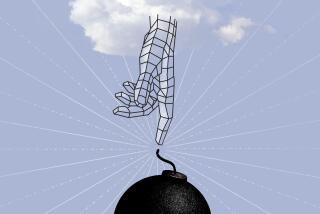BOOK REVIEW : Cyberpunk Reveals Modem Operandi : THE HACKER CRACKDOWN; Law and Disorder on the Electronic Frontier <i> By Bruce Sterling</i> , Bantam; $22.50; 352 pages
A “dark, cynical, morbid cyberpunk” is how Bruce Sterling describes himself. Who could be better qualified to serve as our spirit guide in the world of “cyberspace,” a parallel universe that exists only in the nodes and synapses of the global computer network?
“Although it is not exactly ‘real,’ cyberspace is a genuine place,” writes Sterling, an Austin, Tex.-based science fiction writer whose previous work includes “The Difference Engine” (with William Gibson) and “Involution Ocean.” “(T)his electrical space, which was once . . . little more than a narrow speaking tube, stretching from phone to phone--has flung itself open like a gigantic jack-in-the-box.”
Our descent into what Sterling calls “the digital underground” of hackers and “phone phreaks” begins with an electronic catastrophe on Martin Luther King Jr. Day in 1990, when AT&T;’s long-distance telephone switching system crashed. It turned out that the equipment failure resulted from a flaw in the telephone company’s own software--”one tiny typographical flaw in one single line”--but the incident prompted a series of sting operations, police raids and criminal prosecutions which Sterling characterizes as the “Hacker Crackdown.”
Much of Sterling’s book is concerned with the details of an ugly little war on the digital underground that focused on electronic bulletin boards and the hackers who used them. As Sterling explains, some of the victims were innocent bystanders, including the publisher of an electronic magazine called Phrack whose civil liberties were all-too-casually sacrificed in the search for scapegoats.
Sterling’s sympathy is clearly on the side of the hackers, but the computer cops tend to incriminate themselves by their sheer ham-handedness. For example, the electronic magazine publisher who called himself “Knight Lightning” was prosecuted for publishing an article on the 911 telephone system that had been downloaded from a telephone company computer by an enterprising hacker.
The government characterized the article as a threat to the operation of the emergency telephone system and put a value of $79,449 on the 12 pages of text. But the case fell apart when it was revealed that the very same article was available by mail order from the telephone company for $13.
Sterling may be a sci-fi writer, but he is also an accomplished investigative reporter with a good grasp of the emerging law of computer crime.
His book is funny, full of intriguing facts and perfectly accessible to the lay reader. Although his prose has a hard-edged, here-and-now quality, Sterling pauses now and then in the hectic narrative to invoke the beauty and mystery of cyberspace.
“The stuff we call ‘software’ is not like anything that human society is used to thinking about,” he writes.
“Software is something like a machine, and something like mathematics, and something like language, and something like thought, and art, and information . . . but software is not in fact any of those other things. And the faults in bad software can be so subtle as to be practically theological.”
Sterling zips back and forth in time and place, invoking the odd historical precedents of the computer revolution and summoning up the ghosts of various technological heroes and villains.
He draws a surprising analogy between 19th-Century counterfeiting and 20th-Century computer crime, and he harks all the way back to the pioneering days of the telephone company to explain the inner workings of the digital underground: The earliest telephone operators, he explains, were teen-age boys, but they were quickly replaced with young women who came to symbolize the disembodied presence of Ma Bell.
“Putting teen-age boys in charge of the phone system brought swift and consistent disaster,” he explains. “This combination of power, technical mastery and effective anonymity seemed to act like catnip on (them).”
Nowadays, as Sterling shows us, the very same alchemy sometimes turns some young men (and, less frequently, women) into “techno-cowboys” capable of wreaking havoc with nothing more than a modem and a personal computer.
But “The Hacker Crackdown” demonstrates that much more is at stake in the clash of commerce, technology and the law. Sterling makes a plausible argument that we are heading toward the electronic frontier and that we ought to bring the First Amendment along.
More to Read
Sign up for our Book Club newsletter
Get the latest news, events and more from the Los Angeles Times Book Club, and help us get L.A. reading and talking.
You may occasionally receive promotional content from the Los Angeles Times.






